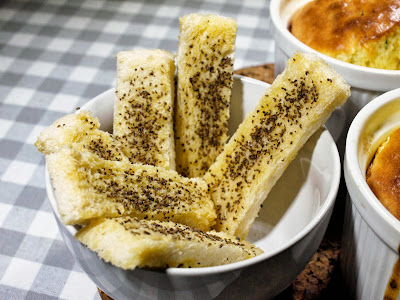From Wrapped
in Pastry, Leigh Drew, Aduki, 2012.
This recipe was actually called ‘Beans and Greens
Parcels’ but I have changed the ‘beans’ to ‘peas’ because I only used chickpeas
and not the cannellini beans.
I
began by mashing a can of chickpeas with a couple of tablespoons of tahini with
salt and pepper. This was put aside as the vegetables were prepared.
Three stalks of spring onions were sliced and
a garlic clove was chopped. These went into a large frying pan to cook in a
little oil for a couple of minutes as I prepared the broccoli and cauliflower.
I used 100g of each vegetable and cut them up into pieces. These now were added to the pan to cook for another couple of minutes. A little water, about ¼ cup, was
added and a lid placed over to let the vegetables steam for a few more minutes.
I washed 500g silver beet and cut out the
hard centre stalks. The leaves were roughly cut into pieces and added to
the pan with the juice of ½ lemon and a teaspoon of chilli flakes. When the leaves
had wilted the mashed chickpeas were added and stirred in. The mixture was left to cool completely.
 The parcels
were now prepared. A sheet of filo pastry was brushed with oil and another
sheet added on top. The vegetable mixture was divided into six lots. One of
these was added to the long end of the pastry strip that was folded over
and over until about half way along. The sides were folded in and the
wrapping continued until fully rolled. It was placed on a baking tray with the
end of the fold down. Now brushed with oil it was ready to go in a 180ºC oven.
The remainder of the vegetables were treated the same way until there were 6
parcels. About half way through the cooking the parcels were turned over.
The parcels
were now prepared. A sheet of filo pastry was brushed with oil and another
sheet added on top. The vegetable mixture was divided into six lots. One of
these was added to the long end of the pastry strip that was folded over
and over until about half way along. The sides were folded in and the
wrapping continued until fully rolled. It was placed on a baking tray with the
end of the fold down. Now brushed with oil it was ready to go in a 180ºC oven.
The remainder of the vegetables were treated the same way until there were 6
parcels. About half way through the cooking the parcels were turned over.
These were
certainly filled with green goodness. They came out like a variation on
spanakopita without the cheese. If making in future I think I would increase the
broccoli and cauliflower to double because I enjoyed their texture and they were a little overbalanced by the silver beet.
Taste: ✔✔✔
Ease of
cooking: ✔✔✔












